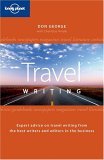
|
Travel Writing by Don George and Charlotte Hindle
|
Review By Michael Shapiro
For the past few summers I’ve had the good fortune of teaching at the annual Book Passage travel writing seminar, near San Francisco. Each year students ask me if I can recommend a thorough, well-rounded book about travel writing. Until now, I haven’t been able to do so; the texts on the market were either hopelessly outdated or gimmicky. But this year I’ll have a solid recommendation: Lonely Planet’s Travel Writing by Don George. I wish this text had been around when I was starting out.
George, formerly editor of Salon’s Wanderlust, and several LP colleagues have written a clear and hard-headed guide to the world of travel writing. The book keenly starts with the allure of travel writing: “that’s not a job, that’s a dream,” George is told at a cocktail party shortly after he lands a plum job as travel editor for the San Francisco Examiner.
But Travel Writing quickly moves beyond the glamor to the hard reality of travel writing, laying out the qualities necessary to be successful. Among these: flexibility, adaptability, frugality, curiosity, perseverance. Targeted to beginners but useful for those with some experience, the book differentiates between destination features, service stories, and personal essays. And before going much further, Travel Writing offers “straight talk about earnings.” In sum, keep your day job — if you’re in it for the money, find another field.
Rounding out the text are dozens of interviews with leading travel writers, editors, and agents in the U.S., U.K., and Australia. Among those interviewed are authors Pico Iyer and Tim Cahill; and editors Keith Bellows of National Geographic Traveler and Simon Calder of the Independent, a UK newspaper. These interviews are enlightening, but because all the contributors are asked virtually the same questions, they can get repetitive. (It appears a form was sent to each and they replied via email.)
Yet in a way this re-enforces the advice. Several writers gave the same word-for-word answer about the best training, saying simply “Write, write, write.” And some added, “Read, read, read,” saying they’re surprised that so many aspiring writers don’t read widely or critically. Both San Francisco Chronicle travel editor John Flinn and Washington Post travel editor K.C. Summers compared bad travel writing to watching your neighbor’s slideshow. You don’t want to see four carousels of their Caribbean slides – why should they want to hear every detail of your trip? The message: be selective. Pick the best scenes, develop characters, evoke all five senses to take us to the place, and you may be on your way to a compelling travel article.
Travel Writing includes several full-length travel pieces as examples of the form. Most of these show the importance of having a quest. Don’t just go to Mexico; go to a little town known for making the world’s finest guitars, as Christopher Reynolds does, in pursuit of the perfect instrument.
Another central theme of the book is accuracy. To be a successful travel writer, you must be a good reporter. “There is simply no excuse for getting your facts wrong,” the book says. This is sage advice because writers won’t get repeat gigs if they make too many mistakes.
Overall, Travel Writing is a valuable introduction to the craft. Many of the travel pros interviewed say don’t focus on being a “travel writer;” just be a writer. Because ultimately it’s the writing that will shine. As Tim Cahill, the great adventure writer says, and I’m paraphrasing: anyone can go out and have an amazing trip, but only a good writer can render a compelling story.
Whether or not you become widely published, traveling with an eye to writing about your discoveries can enrich your journeys. Even if you’re simply writing a letter, or posting an online entry, seeing the world through the eyes of a travel writer can lead to deeper connections with the places and people you visit. And that inner gratification is travel writing’s greatest reward.
Michael Shapiro is the author of
A Sense of Place: Great Travel Writers Talk About Their Craft, Lives, and Inspiration (Travelers’ Tales, 2004), a collection of interviews with the world’s leading travel writers, including Bill Bryson, Tim Cahill, Jan Morris, Pico Iyer, and Paul Theroux. Shapiro’s book includes advice from these and other authors about the craft of travel writing.
|
